mobile Ansicht, to the English Version tap the flag
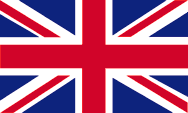

- Republik Kuba
- sozialistische Republik mit Einparteiensystem
- Eigenbezeichnung: República de Cuba
• Flaggen
• historische Flaggen
• Bedeutung/Ursprung der Flagge
• Wappen
• Bedeutung/Ursprung des Wappens
• Flugzeugkokarde
• Landkarte
• Zahlen und Fakten
• Geschichte
• Ursprung des Landesnamens
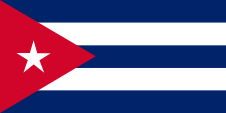
National-, Handels- und Marineflagge,
Seitenverhältnis = 1:2,
Quelle, nach: Wikipedia (D)






Gösch,
Seitenverhältnis = 2:3,
Quelle, nach: Wikipedia (D)



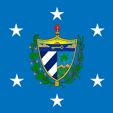
Flagge des Präsidenten,
Seitenverhältnis = 1:1,
Quelle, nach: Wikipedia (EN)




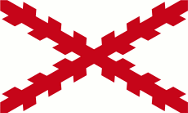
1538–1785,
Flagge Königreich Neu-Spanien,
Quelle, nach: Wikipedia (EN)



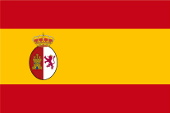
1785–1821,
Flagge Vize-Königreich Neu-Spanien,
Quelle, nach: Wikipedia (EN)




1821–1898,
Flagge Spanisch-Amerika,
Quelle, nach: Wikipedia (EN)




Die Flagge Kubas zeigt ein gleichschenkliges rotes Dreieck am Flaggenmast, mit weißem fünfzackigen Stern darin, ansonsten fünf Querstreifen in Blau und Weiß. Sie wurde im Jahre 1849 – im Vergleich zu heute farblich umgekehrt – von dem venezoelanischen General Narciso López in seinem Neu Yorker Exil und in ihrer heutigen farblichen Gestaltung von dem kubanischen Dichter Miguel Teurbe Tolon für Kuba entworfen. Die Flagge wurde erstmals bei dem großen anti-spanischen Aufstand im Jahre 1850 benutzt, und am 20.05.1902 erstmals offiziell als Nationalflagge gehisst. Das rote Dreieck ist ein Emblem freimaurerischer Herkunft, das für Freiheit, Gleichheit und Brüderlichkeit steht, und für das im Unabhängigkeitskampf vergossene Blut. Die drei blauen Streifen stehen für die damaligen Provinzen des Staates, Weiß für Reinheit, Gleichheit und Frieden, und der weiße Stern (La Estrella Solitaria) ist ein Symbol für Freiheit und Gleichheit, und sollte ursprünglich ausdrücken, dass den USA ein neuer Staat hinzugefügt werden sollte. Auch das Rot, Weiß und Blau sind eindeutige Bezüge auf die "Stars and Stripes". Die Flagge Kubas ist verwandt mit der Flagge von Puerto Rico. Die Buntfarben sind heute unter anderem in Pantone PMS definiert, als Rot = pt 186, Blau = pt 2765. Während des anti-spanischen Aufstandes des Jahres 1868 wurde von Carlos Manuel de Céspedes eine andere Flagge benutzt. Sie zeigte zwei waagerechte Streifen in Weiß und Blau sowie eine rote quadratische Oberecke mit einem weißem fünfzackigen Stern darin. Sie ist noch heute auf Kuba sehr beliebt und wird von der kubanischen Marine als Gösch verwendet.
Quelle:
Die Welt der Flaggen,
Flaggen und Wappen der Welt,
Flags of the World


Wappen von Kuba,
Quelle: Corel Draw 4

Das Staatswappen ist ein Entwurf des Dichters Miguel Teurbe Tolon und zeigt im Schildhaupt, mittels einem goldenen Schlüssel (aus Wappen von Havanna) unter der aufgehenden Sonne, die Lage der Insel. Darüber, als Freiheitssymbol, eine phrygische Mütze über einem Liktorenbündel, als Symbol der Autorität. Im gespaltenen Schild finden sich links Schrägbalken in Blau und Silber, und rechts eine Palmenlandschaft, als Symbol für die Agrarstruktur.
Quelle:
Die Welt der Flaggen,
Flaggen und Wappen der Welt,
Flaggen Wappen Hymnen


1955–1959,
Flugzeugkokarde,
Quelle, nach: Wikipedia (EN)

1959–1962,
Flugzeugkokarde,
Quelle, nach: Wikipedia (EN)
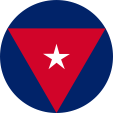
seit 1962,
Flugzeugkokarde,
Quelle, nach: Wikipedia (EN)

Lage:

Quelle: CIA World Factbook
Landkarte des Landes:
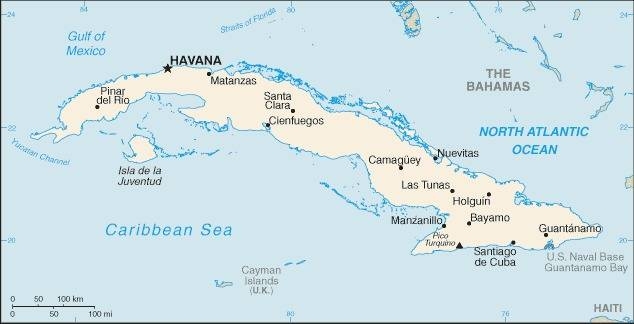
Quelle: CIA World Factbook

Fläche: 109.884 km²
Einwohner: 11.300.000 (2020), davon 64% Europäer, 9% Schwarze, 27% Mulatten
Religionen: 60% Katholiken, 17% Animisten, 23% Nicht-Religiöse
Bevölkerungsdichte: 103 Ew./km²
Hauptstadt: Havanna (spanisch: San Cristóbal de la Habana), 2.121.871 Ew. (2014)
Amtssprache: Spanisch
Währung: 1 Kubanischer Peso (CUP, Cub$) = 100 Centavos
Zeitzone: MEZ – 6 h
Quelle:
Wikipedia (D),
CIA World Factbook

Vorzeit · Besiedelung durch die karibischen Indianerstämme der Guanahatabey, der Siboney und der Taino
1492 · Entdeckung durch Christoph Kolumbus
1500 · Entdeckung des Inselcharakters des Landes durch Juan de la Cosa
1509 · Umsegelung von Kuba durch Ocampo
1511 · spanische Kolonisierung durch Diego de Velázquez, Ausrottung der karibischen Urbevölkerung bis 1532
1523 · Einfuhr von Sklaven für die Plantagenwirtschaft
1850 · anti-spanischer Aufstand
1868 · Ende des Sklavenhandels
1868–1878 · anti-spanischer Bürgerkrieg unter der Führung von Carlos Manuel de Céspedes, Sieg der Spanier
1895 · anti-spanischer Bürgerkrieg, tausende Todesopfer in spanischen Konzentrationslagern
1898 · rätselhafte Explosion des US-amerikanischen Kriegsschiffs „Maine“ vor Havanna, US-amerikanische Militärintervention, spanisch-US-amerikanischer Krieg, Frieden von Paris: Spanien muss sein Kolonialreich – und damit Kuba – zum größten Teil an die USA abtreten, die USA richten auf Kuba Militärstützpunkte ein (Guantanamobucht)
1901 · neue Verfassung
20.05.1902 · Kuba wird formell unabhängig
1906–1909 · US-amerikanische Militärintervention
1919–1924 · US-amerikanische Militärintervention
1925–1933 · Diktatur des Präsidenten Gerardo Machado
1940 · neue Verfassung
1933–1959 · Herrschaft von General F. Batista y Zaldivar
1953–1959 · Guerillakrieg der Revolutionsbewegung des Fidel Castro
01.01.1959 · Sturz von General Batista
1960 · Beginn der Wirtschaftsblockade durch die USA
1961 · Versuch einer Invasion durch Exilkubaner in der Schweinebucht (Playa Girón)
1962 · Stationierung sowjetischer Raketen, Kuba-Krise
1976 · neue Verfassung, Kuba entsendet Truppen nach Angola
1977 · Kuba entsendet vorübergehend Truppen nach Äthiopien
1991 · Abzug der kubanischen Truppen aus Angola
1992 · Verfassungsrevision
1993 · Abzug der sowjetisch/russischen Truppen aus Kuba
1994 · schwere Wirtschaftskrise in Kuba, viele Kubaner flüchten in die USA
1996 · Verschärfung der US-Sanktionen gegen Kuba durch das US-amerikanische Helms-Burton-Gesetz, die UNO verurteilt in einer Resolution das Embargo der USA gegen Kuba
1998 · Lockerung der US-Sanktionen
2014 · Lockerung der US-Sanktionen
2018 · Verschärfung der US-Sanktionen
2019 · neue Verfassung
Quelle:
Atlas zur Geschichte,
Wikipedia (D),
Discovery '97,
Weltgeschichte

Die Bezeichnung "Kuba" geht auf den Namen der Insel zurück, wie er von den karibischen Ureinwohnern verwendet wurde: "Cubanascnan". Er geht auf das Wort "Cubagua" zurück, was soviel heißt wie: "Ort, an dem man Gold findet". Kolumbus, der Insel 1492 entdeckte, hatte ihr zunächst den Namen "Juana" (Name der damaligen spanischen Prinzessin) gegeben, später jedoch "Fernandina" ('Ferdinand' war der Name des damaligen spanischen Königs) verwendet. Letztlich übernahm er jedoch die Bezeichnung der Eingeborenen.
Quelle: Handbuch der geographischen Namen


![]()


















